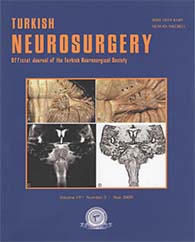Turkish Neurosurgery
2009 , Vol 19 , Num 3
1,2,3,5The University of Texas, M.D. Anderson Cancer Center, Department of Neurosurgery, Houston, USA
4The University of Texas, M.D. Anderson Cancer Center, Department of Neuroradiology, Houston, USA Different portions of the SMA appear to be engaged by different types of neurological functions. It is important to identify the functional activation of SMA in terms of planning the surgical strategy. Our unpublished data from M.D. Anderson suggest that resection of the site of SMA activation based on fMRI is an important parameter for predicting the postoperative neurological deficit. Also, protecting the functional SMA during tumor resection may prevent post-operative deficit. Adjunctive non-invasive intraoperative monitoring techniques such as phase reversal of somatosensory evoked potentials, motor evoked potentials monitoring and subcortical stimulation are very important to identify the eloquent cortical brain areas during tumor resection. Delineation of subcortical pathways using diffusion tensor MRI fiber tracking with intraoperative cortical stimulation may also provide improved preservation of eloquent regions during the surgery. Use of preoperative imaging studies including fMRI, diffusion tensor MRI, intraoperative monitoring techniques and awake craniotomies together in suitable cases may minimize the incidence and severity of the SMA syndrome. Keywords : Functional MRI, Resection, Supplementary motor area
Corresponding author : Mustafa Aziz Hatipoğlu, azizhatipoglu@yahoo.com
4The University of Texas, M.D. Anderson Cancer Center, Department of Neuroradiology, Houston, USA Different portions of the SMA appear to be engaged by different types of neurological functions. It is important to identify the functional activation of SMA in terms of planning the surgical strategy. Our unpublished data from M.D. Anderson suggest that resection of the site of SMA activation based on fMRI is an important parameter for predicting the postoperative neurological deficit. Also, protecting the functional SMA during tumor resection may prevent post-operative deficit. Adjunctive non-invasive intraoperative monitoring techniques such as phase reversal of somatosensory evoked potentials, motor evoked potentials monitoring and subcortical stimulation are very important to identify the eloquent cortical brain areas during tumor resection. Delineation of subcortical pathways using diffusion tensor MRI fiber tracking with intraoperative cortical stimulation may also provide improved preservation of eloquent regions during the surgery. Use of preoperative imaging studies including fMRI, diffusion tensor MRI, intraoperative monitoring techniques and awake craniotomies together in suitable cases may minimize the incidence and severity of the SMA syndrome. Keywords : Functional MRI, Resection, Supplementary motor area





